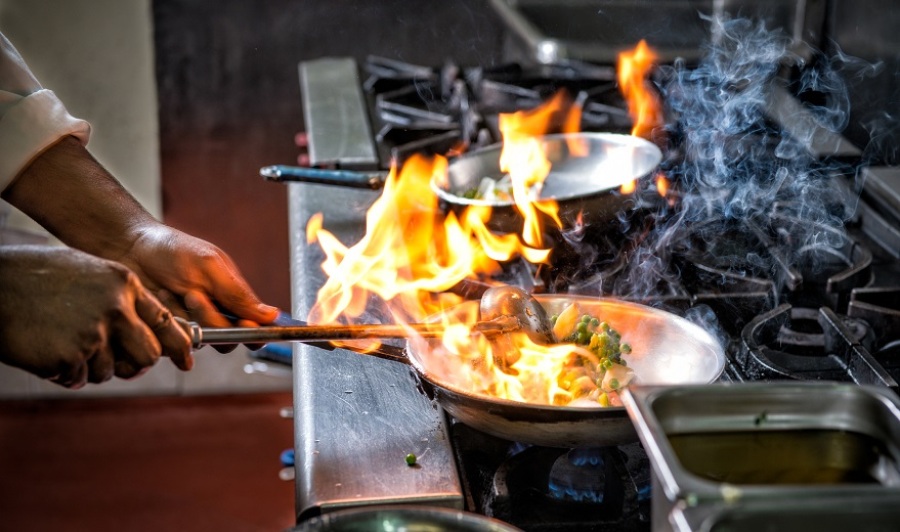🕒 Estimated Reading Time: ~4 minutes

Food delivery has never been so good! Just last month, I ordered a fabulous birthday dinner from a Michelin-starred restaurant in Brooklyn. I also had amazing ethnic food from an award-winning restaurant delivered to my door. It was also about 30% less expensive than eating at the restaurant (which is, of course, is next to if not impossible right now). Whoever would have thought such a happy circumstance could be possible in the midst of a pandemic?
Enter the ghost kitchen.
Even before a pandemic forced dramatic changes in the restaurant world, ghost kitchens were already making waves. A ghost kitchen is a shared working space for multiple restaurants to prepare food. They forego the on-site dining experience to serve customers around the location a diverse mix of food at efficient cost levels.
I know I’m dating myself, but I remember when restaurant began to “co-op” and offer both restaurants’ menus in one location—similar to the co-brand franchise concepts we have today (e.g. a KFC-Taco Bell combo). A customer could have a grilled chicken burger or a taco, depending on their preference. The two brands shared their kitchen and dining room.
<div class="_form_1"></div><script src="https://franchisedirect52345.activehosted.com/f/embed.php?id=1" type="text/javascript" charset="utf-8"></script>
Ghost kitchens take the co-op concept further by eliminating the dining rooms and servers. As a result, the shared facilities of ghost kitchens can become a launchpad for new brands, allowing new delivery-only restaurants to open with less risk. Even food delivery service DoorDash has invested in a ghost kitchen to streamline its services.
Restaurant franchises already feature different methods for getting their menus to the masses (traditional locations, non-traditional locations, drive-thru, food truck, delivery, etc.). A new era of restaurants could be upon us.
These are three big reasons why you might be hearing about ghost kitchens a lot more in the coming months:
- Operating costs are lower. Fewer employees means lower labor costs (always the highest expense in a restaurant). With no need to pay for dining space, dishes, and tables, overall costs go down. If restaurants want to survive, lower costs are necessary. For franchises, this could allow a franchisee to open more than one location, helping to expand the brand at a higher profit. It also encourages more franchise purchases due to lower start-up costs and risk.
- Creativity is valued. A ghost kitchen format focuses on food. It is food (and convenience) that foster successful restaurants, and a ghost kitchen doesn’t have to worry about other factors. Even if it grows into a full-dining experience later, the menu will shine from having been so well developed. For franchises, this model is a good format for experimenting with new flavors and ideas. If a new idea doesn’t work out, the cost of the experiment is low. The ghost kitchen will enhance creative, new dining options.
- Many restaurants in one place means more potential customers. In a ghost kitchen, customers can order from multiple menus on the same order. The benefit for a restaurant is an expanded customer base. When dad wants ribs, but the kids want macaroni and cheese, everyone can be satisfied. And because the shared kitchen economy includes sharing delivery services, the service is better for customers. For franchises, it put the name and brand in front of eaters every time they order.
The potential new era for ghost kitchens in franchising could possibly be here already.
Could this setup be the next frontier for food franchises? As is the case when any new trend comes along, enterprising franchisors will create franchise offerings. In this case, Combo Kitchen is a new food franchise that allows “a franchisee to incorporate up to four different food concepts from an exclusive list of proven brands.”
Another new franchise sporting the concept is The Local Culinary, which is the brainchild of a longtime restaurant operator in Europe who came to the U.S. The Local Culinary already produces food from 20+ virtual restaurants.
Digital food orders and delivery have gone up 300% in the last few years, and that was before the coronavirus forced diners away from brick and mortar locations. Some industry experts estimate that as many as 70% of meals will be takeout by the end of 2020.
Ghost kitchens can increase the different kinds of foods available to customers while providing an opportunity for new franchisees. Ghost kitchens are a trend that has disrupted the traditional ways of the food industry, and could very well end up saving and growing many restaurant franchises. I can’t wait to order my next dinner delivery.
Anne Daniells is a co-owner of Enterprising Solutions, a professional services firm specializing in corporate communication and financial improvement for businesses where she shares decades of corporate and entrepreneurial experience—including franchise ownership—in her writings on business culture. She has authored hundreds of articles for publications including AllBusiness.com, TweakYourBiz.com, and MSN.com. Reach out via her website for more on where corporate culture, communication, and human architecture collide.














